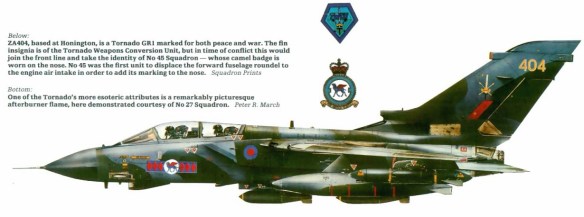The Tornado is possibly the most flexible multimission aircraft in history. Designed as a strike aircraft, it can also perform air-defense, antishipping, and reconnaissance missions with ease.
In the late 1960s Germany, Italy, and Great Britain joined hands to design a basic ground-attack aircraft that would be built and deployed by all three nations. The new machine would have to operate from short runways, deliver ordnance with pinpoint accuracy, and operate in any weather conditions. It would also be optimized for high-speed/low-level operations that are highly taxing to both crew and airframe alike. After extensive studies, the prototype Panavia Tornado IDS was flown in 1974. It was a compact yet highly complicated aircraft, the first European production design to employ variable-geometry wings. The wings are extremely complicated and designed around a number of high-lift technologies that enable it to become airborne quickly. The craft is characterized by a somewhat short, pointed nose, a long canopy seating two crew members, and a very tall stabilizer. Internally, the Tornado utilizes advanced fly-by-wire technology, as well as highly sophisticated navigation/attack radar that combines search, ground-mapping, and terrain-following capabilities. Around 900 Tornados have been built and acquired by the manufacturing nations since 1980. Several dozen have also been exported to Saudi Arabia.
In 1976 Great Britain wanted to develop an airdefense version on its own accord to replace the aging inventory of English Electric Lightnings and McDonnell-Douglas Phantoms. It desired a fast, flexible interceptor to protect NATO’s northern and western approaches. The new Tornado ADV rolled out in 1976 and is distinguished from the IDS variant by a lengthened nose. It houses the advanced Foxhound radar system, which can track up to 20 targets simultaneously at ranges up to 100 miles. The Royal Air Force currently operates 144 Tornado ADVs, and several have been exported to Saudi Arabia. Both versions saw active duty in the 1991 Gulf War and sustained the heaviest losses of any Allied type. They will continue to serve well into the twenty-first century.
Panavia Tornado GR4
The Tornado GR4 is the latest version of the RAF’s primary attack aircraft. Capable of supersonic speeds and flight at low-level, the aircraft is one of the most potent in the world today.
First deliveries to the RAF of the original GR1 version were made in 1980 where it replaced a number of older RAF aircraft including the Buccaneer and Vulcan as low-level attack aircraft. A major feature is the Tornado’s ‘swing wings’ (or ‘variable geometry’ to give it its correct title). With the wings swept fully forward, the aircraft can fly very slowly – ideal for landing on short, unprepared runways. With the wings swept to their full 68°, the aircraft can fly supersonically, whilst at the intermediate position the manoeuvrability is greatly increased – useful should the aircraft need to undertake rapid action during an attack. Another innovative feature of the Tornado is the ability to use thrust-reverse to shorten landings.
A programme to update many of the Tornado’s weapons and navigation systems was completed in 2003 and these updated aircraft are known as Tornado GR4s. As well as the existing weapons carried by Tornados (such as the Paveway family of laser- and GPS-guided bombs and the ALARM anti-radar missile) a number of new weapons can now be used. These include the Storm Shadow stand-off (or ‘cruise’) missile and the RAPTOR reconnaissance pod – both of which were used for the first time during Operation Iraqi Freedom in 2003 and the forthcoming Brimstone anti-tank missile. Other improvements include GPS navigation and changes to the cockpit to allow the use of night-vision goggles.
A reconnaissance version of the Tornado GR4, the GR4A, is in service with the RAF.
Roles
Air Interdiction (AI). Low- or medium-level attacks using precision-guided, freefall or retarded bombs.
Suppression of Enemy Air Defences (SEAD – pronounced ‘see-add’). Attacks on enemy air defence systems such as surface-to-air missile positions with ALARM missiles.
Reconnaissance (using an externally mounted pod).
Armament
One Mauser 27mm cannon and up to 18,000lb of ordnance. Available weapons include Paveway 2 or 3 laser-guided bombs, ballistic or retarded “dumb” 1000lb bombs, Cluster Bomb Units (CBU), Storm Shadow cruise missiles, Brimstone anti-tank missiles, Air Launched Anti-Radiation Missile (ALARM) anti-radar missiles. For self-defence, Sidewinder missiles are carried.
GR4 Specifications
Engines:
Two Turbo-Union RB199s
Length:
54ft 10in (16.70m)
Wingspan:
45ft 7in (13.90m) at 17° sweep; 28ft 2in (8.60m) at 68° sweep
Top Speed:
1,452mph (2,336km/h, Mach 2.2) at 36,000ft (11,000m); 710mph (1,140km/h) at sea-level
Crew:
Pilot and Weapons Systems Operator
